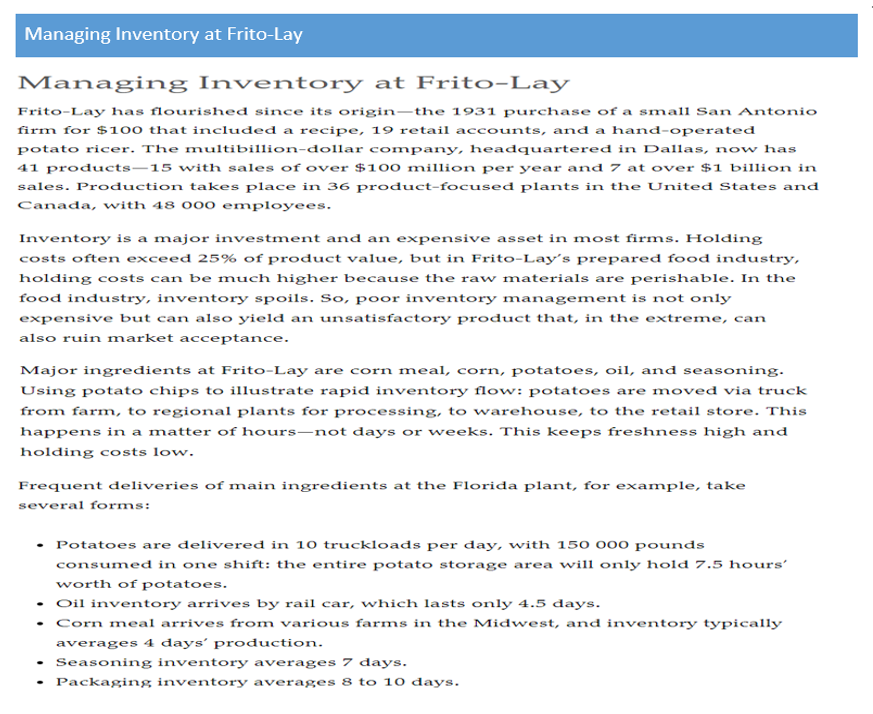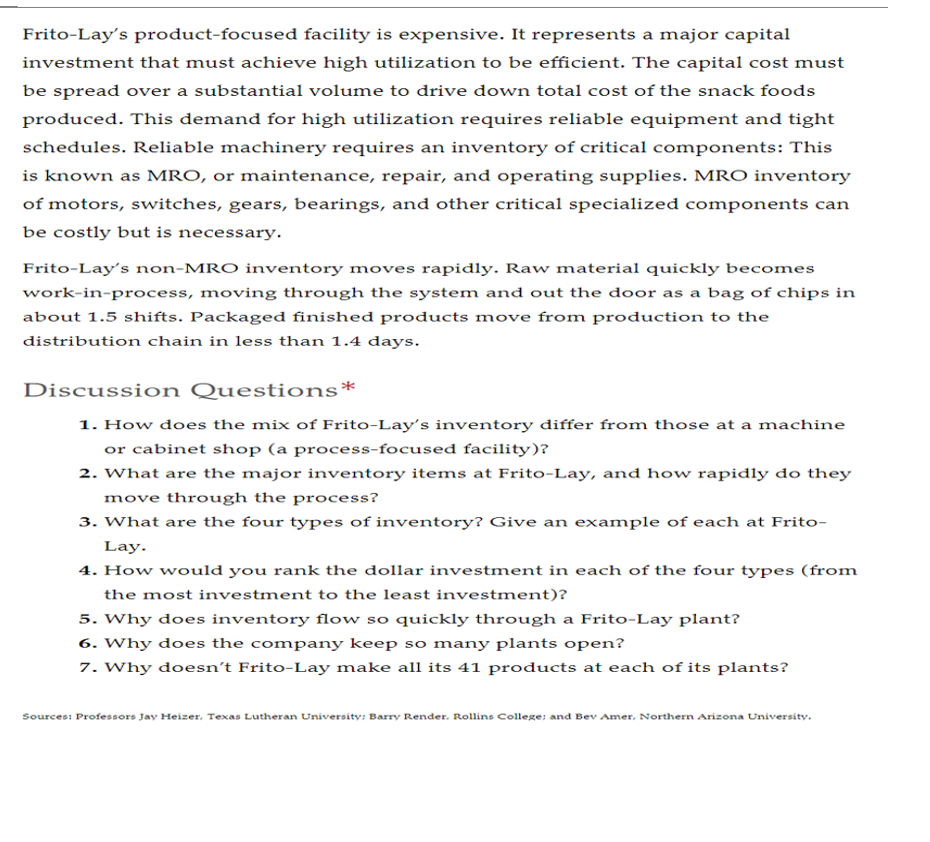How does the mix of Frito-Lay’s inventory differ from those at a machine or cabinet shop (a process-focused facility)?
How does the mix of Frito-Lay’s inventory differ from those at a machine or cabinet shop (a process-focused facility)?
Purchasing and Supply Chain Management
6th Edition
ISBN:9781285869681
Author:Robert M. Monczka, Robert B. Handfield, Larry C. Giunipero, James L. Patterson
Publisher:Robert M. Monczka, Robert B. Handfield, Larry C. Giunipero, James L. Patterson
Chapter16: Lean Supply Chain Management
Section: Chapter Questions
Problem 10DQ: The chapter presented various approaches for the control of inventory investment. Discuss three...
Related questions
Question
1. How does the mix of Frito-Lay’s inventory differ from those at a machine or
cabinet shop (a process-focused facility)?

Transcribed Image Text:Managing Inventory at Frito-Lay
Managing Inventory at Frito-Lay
Frito-Lay has flourished since its origin–the 1931 purchase of a small San Antonio
firm for $100 that included a recipe, 19 retail accounts, and a hand-operated
potato ricer. The multibillion-dollar company, headquartered in Dallas, now has
41 products–15 with sales of over $100 million per year and 7 at over $1 billion in
sales. Production takes place in 36 product-focused plants in the United States and
Canada, with 48 000 employees.
Inventory is a major investment and an expensive asset in most firms. Holding
costs often exceed 25% of product value, but in Frito-Lay's prepared food industry,
holding costs can be much higher because the raw materials are perishable. In the
food industry, inventory spoils. So, poor inventory management is not only
expensive but can also yield an unsatisfactory product that, in the extreme, can
also ruin market acceptance.
Major ingredients at Frito-Lay are corn meal, corn, potatoes, oil, and seasoning.
Using potato chips to illustrate rapid inventory flow: potatoes are moved via truck
from farm, to regional plants for processing, to warehouse, to the retail store. This
happens in a matter of hours–not days or weeks. This keeps freshness high and
holding costs low.
Frequent deliveries of main ingredients at the Florida plant, for example, take
several forms:
• Potatoes are delivered in 10 truckloads per day, with 15o 000 pounds
consumed in one shift: the entire potato storage area will only hold 7.5 hours’
worth of potatoes.
• Oil inventory arrives by rail car, which lasts only 4.5 days.
• Corn meal arrives from various farms in the Midwest, and inventory typically
averages 4 days' production.
Seasoning inventory averages 7 days.
Packaging inventory averages 8 to 10 days.

Transcribed Image Text:Frito-Lay's product-focused facility is expensive. It represents a major capital
investment that must achieve high utilization to be efficient. The capital cost must
be spread over a substantial volume to drive down total cost of the snack foods
produced. This demand for high utilization requires reliable equipment and tight
schedules. Reliable machinery requires an inventory of critical components: This
is known as MRO, or maintenance, repair, and operating supplies. MRO inventory
of motors, switches, gears, bearings, and other critical specialized components can
be costly but is necessary.
Frito-Lay's non-MRO inventory moves rapidly. Raw material quickly becomes
work-in-process, moving through the system and out the door as a bag of chips in
about 1.5 shifts. Packaged finished products move from production to the
distribution chain in less than 1.4 days.
Discussion Questions*
1. How does the mix of Frito-Lay's inventory differ from those at a machine
or cabinet shop (a process-focused facility)?
2. What are the major inventory items at Frito-Lay, and how rapidly do they
move through the process?
3. What are the four types of inventory? Give an example of each at Frito-
Lay.
4. How would you rank the dollar investment in each of the four types (from
the most investment to the least investment)?
5. Why does inventory flow so quickly through a Frito-Lay plant?
6. Why does the company keep so many plants open?
7. Why doesn't Frito-Lay make all its 41 products at each of its plants?
Sources: Professors Jay Heizer, Texas Lutheran University; Barry Render. Rollins College; and Bev Amer, Northern Arizona University.
Expert Solution
This question has been solved!
Explore an expertly crafted, step-by-step solution for a thorough understanding of key concepts.
This is a popular solution!
Trending now
This is a popular solution!
Step by step
Solved in 2 steps

Knowledge Booster
Learn more about
Need a deep-dive on the concept behind this application? Look no further. Learn more about this topic, operations-management and related others by exploring similar questions and additional content below.Recommended textbooks for you

Purchasing and Supply Chain Management
Operations Management
ISBN:
9781285869681
Author:
Robert M. Monczka, Robert B. Handfield, Larry C. Giunipero, James L. Patterson
Publisher:
Cengage Learning

Purchasing and Supply Chain Management
Operations Management
ISBN:
9781285869681
Author:
Robert M. Monczka, Robert B. Handfield, Larry C. Giunipero, James L. Patterson
Publisher:
Cengage Learning